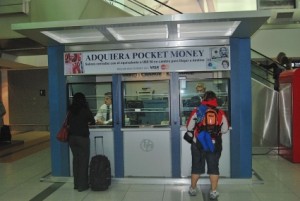
Travelers exchange money at a station in Ezeiza. Photo © Wayne Bernhardson.
Argentina’s money scenario keeps getting stranger and more unpredictable, quickly becoming a major political football (or soccer ball, if you prefer). Concerned (some would say panicky) about capital flight and its ability to pay the bills, the government of president Cristina Fernández de Kirchner is intensifying restrictions on foreign currency purchases, but it’s made some serious missteps.Given most Argentines’ difficulty in obtaining currency to travel beyond their own borders, the biggest blunder was foreign minister Héctor Timerman’s decision to hold his daughter’s three-day wedding celebration at José Ignacio, an exclusive beach destination near the high-powered Uruguayan resort of Punta del Este, for 300 guests at a cost of US$1,000 per person. This spectacle of indulgence by a government official, at a time when ordinary citizens can’t even use their ATM cards outside Argentina, aroused widespread indignation; the next day, Timerman’s daughter announced that the event would now take place in Buenos Aires.
The PR disaster for a government whose principles appeared to be “Do as I say, not as I do” was undeniable. Still, it hasn’t even slowed the meddlesome measures that, so far, have also required Argentines to prove sufficient income to justify dollar purchases for overseas travel. They have also slapped a 15 percent surcharge on credit card purchases on mail-order items outside Argentina.
In theory, departing passengers can still change their Argentine banknotes back into dollars or another currency, but in reality it’s gotten more difficult.So far, the effects of the “dollar clamp” on foreign visitors has been limited, despite a surreptitious black market that I have described elsewhere. On returning from Argentina and Uruguay, reader Greg Mayes of Calgary has informed me that “your recent blog article about Uruguayan reticence to accept Argentine pesos may understate a broader case. Upon our return I went into our local currency exchange, with whom we have a long relationship, and they will no longer accept Argentine pesos for Canadian currency; neither will the banks. Consequently we are left with a currency souvenir we don’t really want. You may want to check if our local situation is a more general case and if so warn your blog readers to get rid of their Argentine pesos before they leave the country.”That’s good advice, but not so simple as it sounds. You should try not to buy more pesos than you need but, if you need to get rid of some on departure, that’s harder than it used to be. The latest measure limits the purchase of pesos on arrival at Buenos Aires’ Aeropuerto Internacional Ministro Pistarini and closes private exchange houses, supposedly to protect innocent foreigners from gouging. Only the state-run Banco de la Nación (whose ATM is the easiest option) will now operate at ports of entry, while kiosks such as the one pictured at top are now closed.
In theory, departing passengers can still change their Argentine banknotes back into dollars or another currency, but in reality it’s gotten more difficult. You will now have to go to the airport branch of Banco de la Nación, stand in line, and show receipts to prove that you obtained your pesos at the legal rate.
Meanwhile, across the river, my friend Manuel Pérez Bravo of Montevideo’s Hotel Mediterráneo informs me that Argentines are still circumventing the clamp over there: “[T]he majority come with Argentine pesos and buy dollars here in Montevideo and then pay their hotel bill. We still don’t know exactly how the Argentine government’s measures will affect us, but we hope they will not cause us too much damage…”
As announced, I will still give a digital slide lecture on Buenos Aires at Tango by the River in Sacramento, but it has been postponed until Friday, September 21st, at 6 p.m.
Limited to a maximum of 50 people, the event will also include tango performances; admission costs $10 at the door, or $8 in advance. I have spoken here several times before, and we always sell out, so plan in advance. Signed copies of my Moon Handbooks on Argentina, Buenos Aires, Chile and Patagonia will be available at discount prices.